NVIDIA GeForce GTX 670 Review Feat. EVGA: Bringing GK104 Down To $400
by Ryan Smith on May 10, 2012 9:00 AM ESTAs always, we’re wrapping up our look at a video card’s stock performance with a look at power, temperature, and noise. As GTX 670 is a lower clocked, lower power, harvested version of GK104, it should do even better than GTX 680 here. Remember, the power target for GTX 670 is only 141W.
| GeForce GTX 600 Series Voltages | |||||
| Ref GTX 670 Boost Load | EVGA GTX 670SC Boost Load | Ref GTX 680 Boost Load | Ref GTX 670 Idle | ||
| 1.175v | 1.162v | 1.175v | 0.987v | ||
Stopping to take a quick look at voltages, we find that NVIDIA hasn’t really adjusted the voltages of GTX 670 compared to GTX 680. Because GTX 670 has a lower maximum boost bin than GTX 680 it ramps up to 1.175v a bit sooner, but otherwise it’s still covering the same range of voltages as opposed to having a lower max voltage to further improve the power consumption. EVGA however does just that, topping out at 1.162v. They’ll need all the power savings they can get since power consumption is inversely proportional to performance under NVIDIA’s power target system.
On that note before we jump into our graphs we wanted to try something new: a look at the average core clockspeed during our benchmarks. Because of GPU boost the boost clock alone doesn’t give us the whole picture – particularly when also taking a look at factory overclocked cards – we’ve recorded the clockspeed of our GPU during each of our benchmarks when running them at 2560x1600 and computed the average clockspeed over the duration of the benchmark.
| GeForce GTX 670 Average Clockspeeds | ||||
| GTX 670 | EVGA GTX 670SC | |||
| Max Boost Clock | 1084MHz | 1188MHz | ||
| Crysis | 1057MHz | 1079MHz | ||
| Metro | 1042MHz | 1066MHz | ||
| DiRT 3 | 1037MHz | 1062MHz | ||
| Shogun 2 | 1064MHz | 1105MHz | ||
| Batman | 1042MHz | 1075 MHz | ||
| Portal 2 | 988MHz | 1034MHz | ||
| Battlefield 3 | 1055MHz | 1080MHz | ||
| Starcraft II | 1084MHz | 1129MHz | ||
| Skyrim | 1084MHz | 1113MHz | ||
| Civilization V | 1038MHz | 1073MHz | ||
| OCCT | 953MHz | 980MHz | ||
In spite of the GTX 670’s boost clock of only 980MHz, we see that it spends almost its entire time above that, and indeed spends its whole time above the base clock. As far as games go, with the exception of Portal 2 it’s always in the mid-1000s, whereas the GTX 680 was only a bit higher at the high 1000s. This is a big part of why the GTX 670 has performed so well in our tests: it may be rated lower, but in fact it can reach clockspeeds very close to the GTX 680.
At the same time this is why we see the EVGA GTX 670 Superclocked struggle to separate itself from the reference GTX 670, in spite of a 6%+ factory overclock. Too much of the time it’s simply not boosting much higher than the reference GTX 670, which limits the performance gains. With GPU Boost in effect this means there are a range of cards and we could be looking at a particularly good reference GTX 680, but whether that’s the case or not the end result is that EVGA’s card can’t do too much amidst the 141W power target limit.
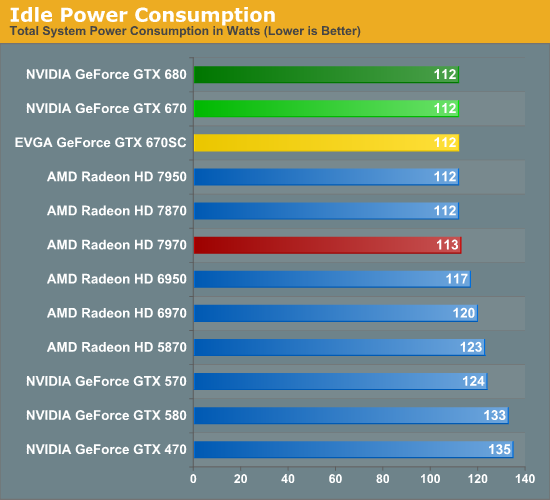
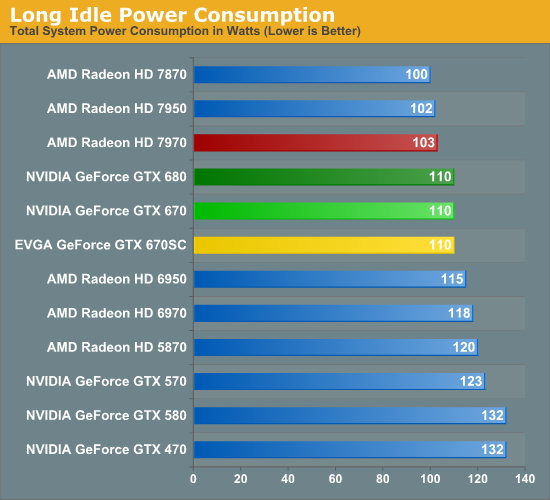
Starting with idle power, there aren’t any major surprised compared to the GTX 680. NVIDIA and AMD have both done such a good job managing their idle power consumption that even with the disabled SMX there’s no measurable difference between video cards. GTX 680 and GTX 670 effectively have the same idle and long idle power consumption.
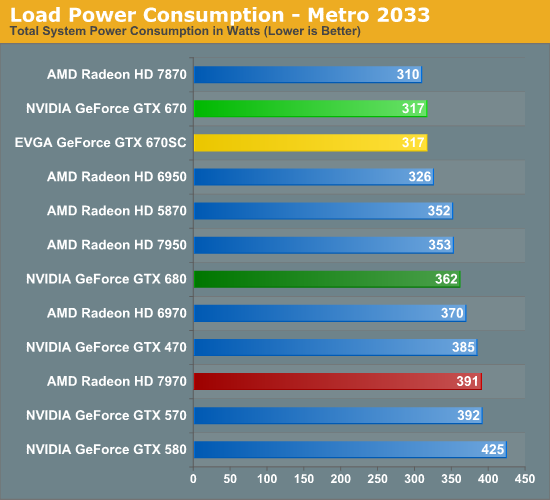
Moving on to load power consumption we can immediately see the GTX 670’s lower power target come into play. At 317W from the wall it’s 45W less than the GTX 680 for roughly 90% of the gaming performance, and this is in fact is lower power consumption than anything except the Radeon HD 7870. Even the GTX 560 Ti (which isn’t in this chart) is higher at 333W, reflecting the fact that GK104 is the true successor to GF114, and which would make GTX 670 the successor to GTX 560 from a design perspective.
Of course this also means that GTX 670 does very well for itself compared to AMD’s cards. We saw GTX 670 slightly outperform 7950 in Metro and here we see it drawing 36W less at the wall at the same time. Or compared to the 7970, 7970 can outperform GTX 670 by about 10%, but we’re drawing 74W more at the wall as a result.
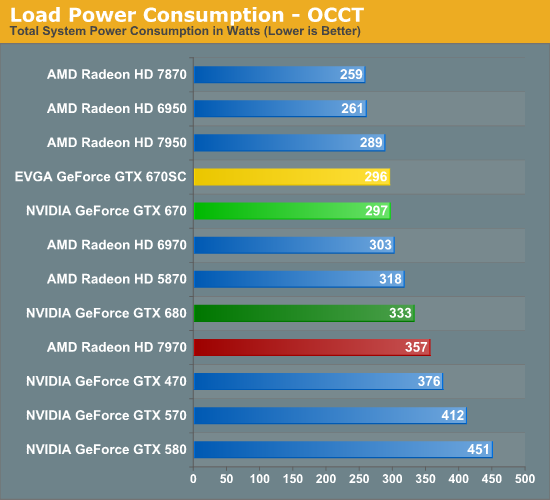
Relative power consumption shifts slightly under OCCT, but the story is otherwise similar. It’s not immediately clear why GTX 670’s power consumption is slightly higher than 7950 even after what we saw with Metro (PowerTune should be capping at 200W), but at least in this test the GTX 670 does end up doing a bit worse. On the other hand it’s still 60W less than the 7970.
Otherwise if we compare the GTX 670 to the GTX 680 we see that the GTX 680 ends up drawing 36W more at the wall, only a bit less than the difference we saw under Metro and quite close to what we’d expect based on the cards’ specifications.
On a related note, pay close attention to NVIDIA’s power target system in action here. In spite of the fact that the GTX 670SC is a binned part running at a lower voltage and higher clockspeeds, it’s drawing 1W less than the reference GTX 670. It would appear that NVIDIA has very good control over their power consumption overall, even if they can only adjust clocks for it a few times per second.
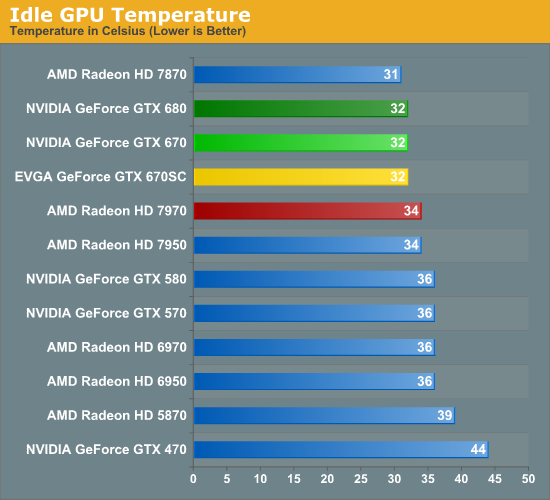
Seeing as how NVIDIA is using roughly the same cooler design with GTX 670 as they are with GTX 680 and they have the same idle power consumption, it should come as no surprise that temperatures are so similar. 32C is among the lowest of the temperatures we’ll see for a blower unless it’s running fast & loud.
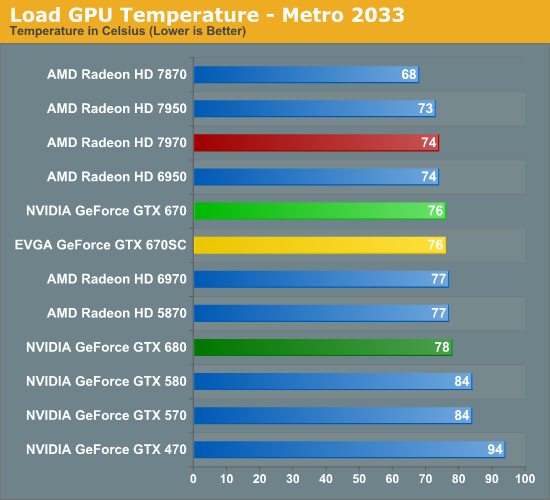
Thanks to the lower power consumption of the GTX 670 temperatures have gone down as well. 76C is still 2C warmer than the Radeon HD 7900 series due to AMD’s more aggressive cooler but it’s 2C cooler than the GTX 680. The thermal threshold for GK104 is 98C, which means there’s still over 20C of thermal headroom to play with here.

OCCT pushes temperatures up some, but not by much thanks to NVIDIA’s power target system. Since the GTX 680 tied the 7970 at 79C here, this means the GTX 670 is 2-3C cooler than both the GTX 680 and the 7970, and 0-1C warmer than the 7950.
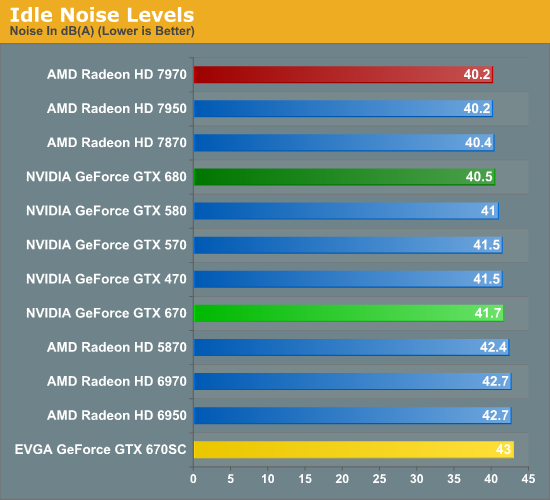
Unfortunately the impressiveness of the GTX 670 begins to wane some here at noise. NVIDIA tells us that the GTX 670 uses the same fan as the GTX 680 but this seems questionable. 41.7dB is not significantly louder than the GTX 680’s 40.5dB, but there’s a definite difference in pitch compared to the GTX 680. The GTX 670 seems to have a low pitch hum/grind to it that GTX 680 didn’t have.
Meanwhile EVGA’s card fares the worst here, at the precipice of falling out of the quiet zone. Since it’s using what’s fundamentally the same fan and cooler as the reference card, the only practical explanation is that EVGA’s smaller diameter fan intake has a negative impact on fan noise.
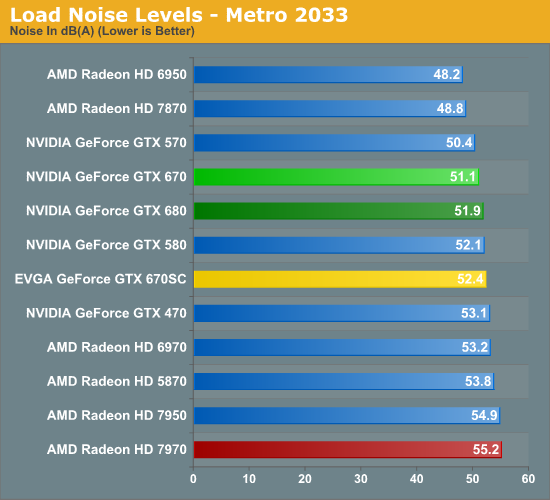
Finally, when looking at load noise we see that the GTX 670 doesn’t fare significantly better or worse than the GTX 680 here. At 0.8dB quieter than the GTX 680 the GTX 670 is a smidge quieter, but it’s nothing that’s particularly appreciable. Perhaps the more important fact is that this is 3.8dB quieter than the 7950 and 4.1dB quieter than the 7970, making the GTX 670 notable quieter than either 7900 series card. In practice the only place the GTX 670 loses is oddly enough to the GTX 570. The GTX 570 was 0.7dB quieter than the GTX 670 despite the former’s much higher power consumption. NVIDIA did let the GTX 570 get hotter than the GTX 670 so it looks like the GTX 670’s fan curve is a bit more aggressive than the GTX 570’s.
As for the EVGA GTX 670 Superclocked we’re seeing the same thing that we saw at idle: it’s just a bit louder than the reference GTX 670. This is in spite of the fact that the GTX 670SC’s fan actually went to the same speed as the reference GTX 670’s fan in this test.
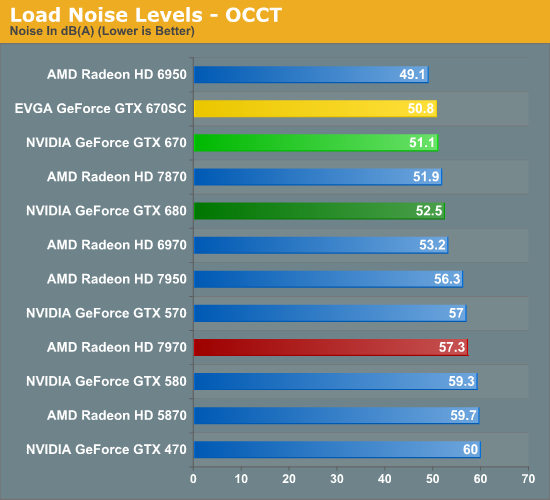
NVIDIA’s power target once more makes itself known here, thanks to which power consumption and thereby heat generation increases very little compared to what we saw under Metro. This widens the gap between the GTX 670 and 7900 series, which is now at 5.2dB and 6.2dB compared to the 7950 and 7970 respectively. Or compared to NVIDIA cards this is 1.4dB quieter than the GTX 680 and nearly 6dB quieter than the unthrottled GTX 570.
Meanwhile there’s something very interesting going on with the GTX 670SC that’s a wider reflection of the GTX 670’s reference fan. The fan speed went up but objective noise (A-weighted) went down. Why? That low-pitch hum we mentioned diminishes with a higher fan speed, and as a result the fan gets quieter once it passes a certain threshold. Subjectively we agree with our sound meter: the GTX 670SC sounds quieter here than it does as the lower fan speed it uses for cooling during Metro. We haven’t experienced anything like this with the GTX 680, which makes us further doubt that the fans are identical between the GTX 680 and GTX 670. Close no doubt, but not the same.
Wrapping things up this entire scenario is very similar to how we saw the launch of the GTX 680 play out. NVIDIA has a strong performing part with less noise and less power consumption than either its 500 series predecessors or AMD’s closest competition. This in turn was a big part of what made the GTX 680 so easy to recommend, as better performance with less noise is exactly the kind of direction we like to see video cards move in.










414 Comments
View All Comments
Galidou - Sunday, May 13, 2012 - link
LoL you're still so much into it's almost like you wanna make me feel that you're gonna save the world with your knowledge. Pollution will be eradicated by the light of your mesurements(in milimeters that is).Sorry if my english ain't at your level, maybe why you beleive I'm young, but it is in fact my third language. The only fanboy here is you, I know that this 670 is AMAZING, if I were in the market for a 300$ video card with what I see now, I'd dish an extra 100 to get it without hesitation.
OMG sonny boy you had to mention this like it was all the supernatural 6mm difference... who gives a darn but you... If you're that old and ''responsible'' commenting like you do about video cards, WOW, it's even worse than I think, the word responsible might even have to change definition just because of you.
I have never seen someone so irresponsible in forums when speaking about video cards. And I'm not the only one who might think that way for sure.
You'Ve been doing personnal attacks on this forum on a regular basis and all that because of what, because of your knowledge in video cards. I'd prefer to be the most stupid man on earth instead of using any form of knowledge the way you do.
CeriseCogburn - Sunday, May 13, 2012 - link
Another gigantic wall of text with nothing on the topic, and nothing but attacking. Goodbye, you missed all the discussions, and all you've got to add now is your hatred.Galidou - Monday, May 14, 2012 - link
I never said your discussions were fulled with lies or anything, it's just the way you bring up your argumentation. It makes me feel like not everyone will listen to you because of that. You do it in a harsh way and bring everyone down with you at the same time.You think calling everyone an ignorant is really necessary to explain anything related to the topic even if their argumentation is flawed? I don't think so. I already know Nvidia won for this gen, and they won big time. It's nice to see some nice bang for your bucks at the top, and I mean, if it wasn't for the fact that I only run in 1080p and the most anticipated game I'll play is diablo 3, I'd get one right now. But darn it dude, calm down...
CeriseCogburn - Thursday, May 31, 2012 - link
You calm down amd fanboy, you LOST, amd LOST, and is LOSING, and amd is near broke.And you're very upset over it.
Gastec - Tuesday, November 13, 2012 - link
Aha! Busted! You are looking forward for AMD to get broke, closed so we would all be forced to buy video cards from only one corporation: nVidia. Because that way your share of money will get bigger. You greedy bastard!jamyryals - Friday, May 11, 2012 - link
While highly entertaining to me, your comments are actually a bit disturbing when one thinks about what you are like in real life.CeriseCogburn - Friday, May 11, 2012 - link
Yes, don't forget to personally attack me, use the usual blabber the most ignorant and clueless fools on the net use to do so, it's a very short list, so it won't be too hard for you unless you try to remember how to spell basement.Now back to the topic I brought up.
It's a sad time for amd fanboys and no amount of lies can help.
After the reviewer smacked down all 79xx CF setups as not able to recommend, we have this very next follow up review - and it's easy to say everyone is absolutely amazed by the massive performance of this next step nVidia GTX670 - beating amd and their fanboys at the very heart and I do mean their dark little love it to death fanboy talking point amd heart - die size / power use / price perf / fan noise...
It's a total and complete smackdown, exceeding even in muliti monitor with the nVidia 3+1surf - a complete smackdown - no area left for the and fanboy to grab onto - extreme sadness the era has ended.
Consolation prize is vehemently claiming amd "OC's better", but it's a very difficult and voltage increasing road of heat and instability to that little nugget - while the nVidia fan comfortably uses a new technology for OC, and "enjoys some OC anyway" even without touching a thing, if we are to believe the angry and defeated amd fans protestations..
SlyNine - Saturday, May 12, 2012 - link
You need to take a step back and read your comments. You seem to think you're the only person with a valid opinion.CeriseCogburn - Sunday, May 13, 2012 - link
Oh more personal attacking ?You can have your opinion, even if it's ridiculous and stupid, and rest assured, I may use the facts to prove that it is, and thus, you may whine I seem to think only my opinion is valid.
I see now you went on a half page excuse rant for amd in the prior page trying to justify it's terrible loss with much spinning and distortions - look buddy, why don't you take some of your own advice ?
It's obviously very important to you, given your actions - so it would be better if you made more attempts like the one I just referred to, and also had the guts to correct those spinning and lying for amd, as then I wouldn't be so busy.
We can thank snakefist for pointing out past page 25 here that the nVidia core size is 294mm on a side not 300mm - so there we go again, another lie by an amd fan corrected...
( to be fair there was some misinformation concerning that comporting to the error the poster made)
Thanks for telling me to read my own posts, I assure you I do, although now I've skipped reading your entire rant on the prior page. It's laughable BTW.
haakon_k - Saturday, May 12, 2012 - link
While a bit entertaining to me, your comments are actually highly disturbing when one thinks about what you are like in real life.*my version